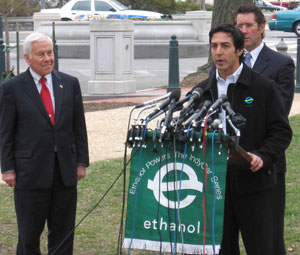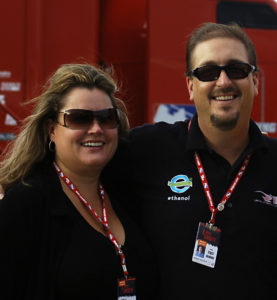EPIC Global Warming Expedition
In early 2007, the Ethanol Promotion and Information Council (EPIC) had the unique opportunity to highlight the role ethanol can play in addressing global climate change by joining legendary polar explorer Will Steger for his 2007 Global Warming 101 Expedition.
“There’s never been a more critical time to act. The debate is over,” said Steger when the partnership was announced in January 2007. “Ethanol is available now to consumers. A renewable fuel, it’s a critical part of the solution.”
Only days later, U.S. Energy Secretary Samuel Bodman echoed those same sentiments during an administration press conference when the Intergovernmental Panel on Climate Change report The Physical Science Basis for Climate Change was released.
“Human activity is contributing to changes in the Earth’s climate,” said Bodman. “That issue is no longer up for debate.” Bodman said the Bush administration’s energy policies “go hand in hand with our efforts to address climate change,” with an emphasis on more research for hydrogen, solar power and ethanol production technologies.
“The report findings highlight the need for robust climate research and the development of new technologies to clean our air and deal with global climate change, while maintaining economic competitiveness.”
Ethanol is Cool in the Cold
The purpose of Steger’s expedition was to give a voice to the Inuit people.

EPIC’s sponsorship of Steger’s expedition included sales of polar teddy bears wearing ethanol t-shirts
When Steger went looking for sponsors to support his Global Warming 101 expedition, he decided that the ethanol industry would be a natural choice.
“I’ve been talking up the benefits of ethanol for 18 years,” Steger said during an interview at a sendoff event for the team in his hometown of Ely, Minnesota. “I wrote a book in 1988 and in that book I talked about ethanol as being one of the solutions.”
Steger said he really believed if Americans use more ethanol it will make a positive difference in the global climate situation and it has other benefits as well. “It’s best for our economy and our national security and above all supporting our people in the rural areas,” he said.
Steger approached Minnesota-based ethanol plant builder Ron Fagen, president of Fagen, Inc. in Granite Falls. Ron not only jumped at the opportunity, he brought EPIC on board as well.“The world has become acutely aware that the use of fossil fuels is warming our planet at an alarming rate,” said Fagen. “We are honored to support his efforts to document these effects and inspire changes that will halt this trend.”
Ron and his wife Diane were personally supportive of Steger’s mission and traveled to attend sendoff events for the team like the one in Ely where he was interviewed as part of a documentary about the expedition. “We’re doing our part to fight global warming,” Fagen said, bundled in a down coat and mukluks in a make shift studio where the Will Steger Wilderness Center was under construction and the outside temperature was 25 degrees below zero.
“Will Steger’s expedition is fantastic and the timing couldn’t be more perfect,” said Fagan. “Probably 90 percent of the population believe global warming is for real.”
EPIC Expedition Comes to an End
 The Global Warming 101 expedition concluded May 18 in small remote fishing and hunting community of Iqaluit. Fagan and EPIC executive director Tom Slunecka both traveled to welcome the team and congratulate them on a successful journey.
The Global Warming 101 expedition concluded May 18 in small remote fishing and hunting community of Iqaluit. Fagan and EPIC executive director Tom Slunecka both traveled to welcome the team and congratulate them on a successful journey.
“Most people wouldn’t think that there’s a connection between biofuels and the Arctic circle,” Slunecka said. “But as we’ve discovered, ethanol’s ability to reduce harmful gases that contribute to global warming is dramatic, and there’s no more dramatic place to see it than to go to the North Pole.”
Slunecka talked about some of the changes seen by the Inuit. “The elders in the tribes have seen a large change in insects, birds and plant life now being introduced in the region,” he said. “With the warming climate, they are very concerned about new diseases being introduced that will ultimately affect everyone who lives in the region.”
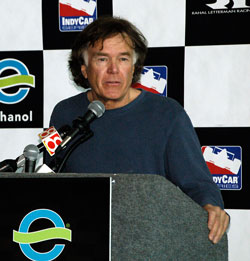 Just a week later, Steger was the star attraction at the Ethanol Summit held for the media prior to the 91st Indianapolis 500, the first to run on 100 percent ethanol.
Just a week later, Steger was the star attraction at the Ethanol Summit held for the media prior to the 91st Indianapolis 500, the first to run on 100 percent ethanol.
Narrating a slide show of his various expeditions across frozen ice lands in Antarctica, the North Pole and the Greenland ice cap, Steger spoke of temperatures 30 degrees below freezing with 30 mile an hour winds where he witnessed evidence of significant climate change causing large remnants of ice from the last ice age to break up and begin to melt. “The diminishing summer sea ice suggests the earth is experiencing unnatural climate changes,” said Steger.
“We’ve already risen about a degree or so, which doesn’t seem like much, but that rise will continue with all the carbon we’re putting into the atmosphere right now,” said Steger in an interview at the Ethanol Summit. “That’s why we’ve got to take seriously the solutions, things like ethanol and other biofuels.”
“I think the United States is taking the leadership in technology for biofuels,” Steger continued. “I think Americans need an issue like global warming and biofuels to bring the country together.”
Dana’s Dream Realized
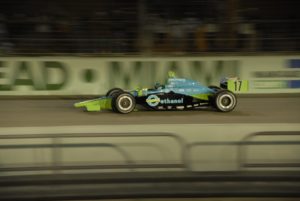 The XM Satellite Radio Indy 300 made history in Homestead, Florida on March 24, 2007 as the first race to run on 100 percent ethanol. It was a bittersweet and emotional milestone for many remembering Paul Dana’s tragic death prior to the same race a year ago.
The XM Satellite Radio Indy 300 made history in Homestead, Florida on March 24, 2007 as the first race to run on 100 percent ethanol. It was a bittersweet and emotional milestone for many remembering Paul Dana’s tragic death prior to the same race a year ago.
Besides the legacy Dana left behind with IndyCar Series moving to 100 percent ethanol, he left an even more important legacy to his wife and family – his son, Conor Paul, who was born in December 2006, just a few weeks shy of nine months after Paul’s death.
“Paul, and Tonya his wife, and now baby Paul have really been in everybody’s thoughts,” said Team Ethanol driver Jeff Simmons, who replaced Dana after his death. “It’s important to me to be able to honor Paul as best I can by promoting the cause he believed in and the cause to which I have become an instant convert as I’ve learned about ethanol.”
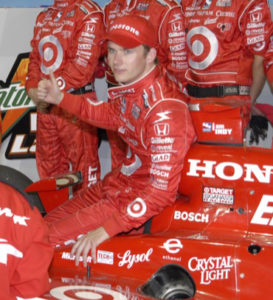 Simmons and the Team Ethanol car were unfortunately out of the race early due to a collision with two other cars and the race was eventually won by the dashing Brit Dan Wheldon. During the victory press conference, Wheldon was asked what he thought about running on 100 percent ethanol.
Simmons and the Team Ethanol car were unfortunately out of the race early due to a collision with two other cars and the race was eventually won by the dashing Brit Dan Wheldon. During the victory press conference, Wheldon was asked what he thought about running on 100 percent ethanol.
“First of all, we are the first motor racing series to do that and certainly Indy Car Series should be proud of that,” said Wheldon. “You have to give credit to their partner Honda as well, you’ve got to work together to do that. I would say that anything that you can do that is better for the environment is a good thing, so we’re very happy about that.”
The big winner that night was ethanol. The official name for the race may have been the XM Satellite Radio Indy 300, but on ESPN2 it was called the 2007 Ethanol IndyCar 300 Presented by XM. ESPN2 coverage of the race included the “e” brand on graphics, features about the fuel, regular mentions that the drivers were “filling up with ethanol” and the brand new 30-second ethanol television spots. ESPN2 on-line coverage includes side and top banners for ethanol. People watching the race could hardly fail to know that the cars are now running on 100 percent fuel-grade ethanol and every car in the race had the “e” logo above the fuel tank cap.
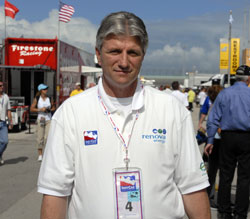 Renova Energy’s Wyoming Ethanol plant in Torrington, Wyo., was the exclusive supplier for the race, shipping 5,000 gallons of ethanol across the country to Homestead-Miami Speedway for use by IndyCar Series teams. Dan Schwartzkopf was general manager for the plant at that time and was pleased they were able to be part of the historic event. “It’s made the broad statement that the ethanol industry is for real,” said Schwartzkopf during an interview that day. “We’re building that yellow brick road, so to speak, and when people can come to a motor sports venue like this and see all the vehicles running on it and high performing, it takes away the skepticism that people once had.”
Renova Energy’s Wyoming Ethanol plant in Torrington, Wyo., was the exclusive supplier for the race, shipping 5,000 gallons of ethanol across the country to Homestead-Miami Speedway for use by IndyCar Series teams. Dan Schwartzkopf was general manager for the plant at that time and was pleased they were able to be part of the historic event. “It’s made the broad statement that the ethanol industry is for real,” said Schwartzkopf during an interview that day. “We’re building that yellow brick road, so to speak, and when people can come to a motor sports venue like this and see all the vehicles running on it and high performing, it takes away the skepticism that people once had.”
Schwarzkopf, who started racing on ethanol himself in the mid-1990s, said it had been a long road to get ethanol on that track, and he was glad to see what Paul Dana had given his life to do was accomplished. “We’re living some goals and some dreams here,” he said.
Riding the Indy Wave
The Indy Racing League partnership gave ethanol new found credibility and helped EPIC continue to rally support for increasing the RFS.
The event, organized by EPIC and RFA, also featured Indiana’s other Senator Evan Bayh and Sen. Norm Coleman of Minnesota. “Lawmakers understand that ethanol is bringing a change in this country,” said Executive Director Tom Slunecka. “Our dependence on foreign oil is being reduced by the use of ethanol and they want to make sure that the momentum continues to grow so they turned out today to help show their support.”
Even California Democrat and Speaker of the House Nancy Pelosi was supporting ethanol in 2007, singing its praises at the National Farmers Union (NFU) Convention in Orlando. “Because we believe we must renew our commitment to renewable energy and fuels from the farm as opposed to our continued reliance on foreign oil,” said Pelosi. “By making the investments we need to make in renewable energy, we can turn America’s farms and fields into the victory gardens of the 21st century.”“From corn in the Midwest to soybeans in North Carolina, you grow the crops that can be converted into biofuels that power our cars and trucks,” she continued. “Now that Democrats are in the majority, we plan to pass into law energy independence solutions that are American owned and home grown.”
During that convention, National Farmers Union delegates approved a policy position to enhance energy and environmental opportunities for rural America which includes supporting expanded research and development dollars for renewable energy technology; expanding the Renewable Fuels Standard; establishing a Renewable Portfolio Standard that requires 25 percent of energy usage to come from renewables by 2025; incentives for local ownership of renewable energy production; and extension and expansion of renewable energy tax credits, including permanent extension of the renewable energy production tax credit.
2007 Indy 500 Celebrates Greening of Racing
The 91st Indianapolis 500 served as a backdrop for a month-long promotional tour for Team Ethanol and driver Jeff Simmons, including a visit to the Chicago Board of Trade for a tribute to the “Greening of Racing” and a salute to the IndyCar® Series.
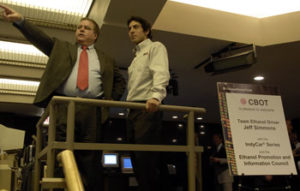 “Ethanol is sharing the track with a great American past time,” said CBOT Chairman Charlie Carey. “For the first time a renewable fuel will power a vehicle past the checkered flag at the Indy 500. Congratulations to the IndyCar Series.”
“Ethanol is sharing the track with a great American past time,” said CBOT Chairman Charlie Carey. “For the first time a renewable fuel will power a vehicle past the checkered flag at the Indy 500. Congratulations to the IndyCar Series.”
Simmons opened the event by driving up in an IndyCar Series vehicle on CBOT Plaza and later stood on the platform with Carey for the ringing of the opening bell on the trading floor.
“When we go out there Memorial Day weekend for the 91st running of the Indianapolis 500, it’s really going to be a proud moment for all of us to be a part of the ‘greening of racing,’” said Simmons. “This is something that’s not only good for American and our environment, but also for the performance of your car and good for the security of our energy future.”
Government officials also joined in the CBOT event.
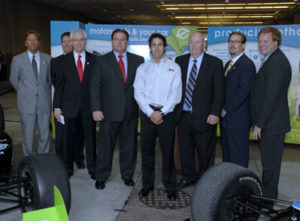
Pictured from left to right are Terry Angstadt, IndyCar Series president; CBOT Executive Vice-President for Marketing and Business Development Chris Malo; USDA Under Secretary for Rural Development Thomas Dorr; CBOT Chairman Charlie Carey, Team Ethanol car driver Jeff Simmons; Illinois Director of Agriculture Chuck Hartke; EPIC Executive Director Tom Slunecka; and Doug Scott, Director of the Illinois Environmental Protection Agency
Prior to the opening bell, CBOT Executive Vice-President for Marketing and Business Development Chris Malo talked about how the commodity exchange created ethanol contracts as a price discovery tool for the industry. “When we launched our ethanol futures contract in March 2005 we knew we were early to the market place,” said Malo. “However, we recognized the increasingly important role that ethanol can play in meeting the nation’s energy needs before ethanol became a daily news story.”
U.S. Department of Agriculture Undersecretary for Rural Development Thomas C. Dorr played a part in the tribute, detailing the enormous growth of the ethanol industry. “Ethanol production in 2000 was 1.6 billion gallons, today its six billion gallons and new capacity under construction will add another 6.4 billion gallons,” said Dorr. “Cellulosic ethanol will give us the potential to supply a third or more of our liquid fuels.”
Tom Slunecka, Executive Director of the Ethanol Promotion and Information Council (EPIC) said that ethanol has become more than just a product. “Ethanol is a movement,” he said. Besides being proud to partner with the Indy Racing League, Slunecka says EPIC is “proud to partner with the American consumer to help change our future.”
Terry Angstadt, IndyCar Series president, says the partnership with ethanol fits in perfectly with their mission. “The Indianapolis Motor Speedway was built in 1909 literally as a test track to support the auto industry in technology and innovation,” he said. “That’s why the association with the ethanol industry, EPIC, the Rahal Letterman race team, Jeff Simmons is a perfect association for a business and series that is so aligned with technology and innovation as our cornerstone.”
EPIC Indy 500
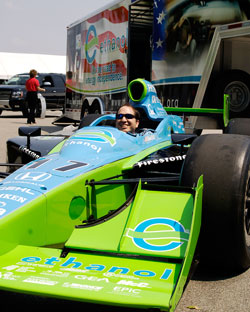 The 2007 Indianapolis 500 was an EPIC event for the ethanol industry with days of festivities leading up to the race including ethanol pump promotions, radio remotes, vehicle giveaways and an Ethanol Summit for the media featuring government and industry officials.
The 2007 Indianapolis 500 was an EPIC event for the ethanol industry with days of festivities leading up to the race including ethanol pump promotions, radio remotes, vehicle giveaways and an Ethanol Summit for the media featuring government and industry officials.
U.S. Assistant Secretary for Energy Efficiency and Renewable Energy Andy Karsner suited up at the Ethanol Summit in an official Ethanol flame-repellent suit and hopped into the seat of a replica Ethanol car. Karsner called ethanol “a key part of the solution to combating global warming,” not a silver bullet but rather “part of the silver buck shot.”
EPIC Board President Tom Branhan, CEO and general manager of Glacial Lakes Energy, said the transition to 100 percent ethanol fuel in the Indy Racing League was major for the ethanol industry but they already had their sites on other venues to show the power and potential of the corn-based fuel. “We’re going to go from Indy to the Le Mans Series and we’ve already been talking to the NASCAR series as well,” he said. The Le Mans Series partnership was already underway in 2007 with a 10 percent blend, but it would be several years yet before NASCAR begins to use ethanol blended fuel.
 When race day arrived on May 27, rain threatened to delay the start, but a short wait, Super Bowl MVP Peyton Manning waved the green “e” flag to start the 91st Indianapolis 500 on a soggy track.
When race day arrived on May 27, rain threatened to delay the start, but a short wait, Super Bowl MVP Peyton Manning waved the green “e” flag to start the 91st Indianapolis 500 on a soggy track.
On lap 113, the race underwent a lengthy rain delay, with Tony Kanaan tentatively sitting as the leader. After three hours, the rain ceased, the track was dried, and the race restarted shortly before 6:15 p.m. EDT. A crash on lap 162 between Dan Wheldon and Marco Andretti brought out the yellow flag with Dario Franchitti leading. Under the caution, rain began falling again and officials halted the race on lap 166. Dario Franchitti was declared the winner after leading 34 laps during the race.
“I’ve had absolutely no problem with ethanol, it works quite well,” said Franchitti during the winner’s press conference. “We were getting pretty good fuel mileage under the yellows today so I was quite happy for that.”
Simmons Replaced by Hunter-Reay
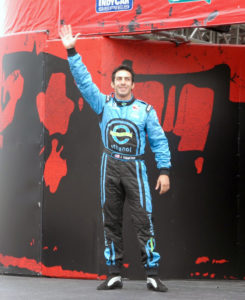 The Indy 500 was one of the better ones that year for Ethanol Team IndyCar Driver Jeff Simmons, at least until the rain delay. Simmons held a top 3 position for much of the first 113 laps, even holding first place just before the rain delay. But, just as he pulled into the pits to refuel, the yellow flag dropped pushing Jeff back to 7th. He ultimately finished 11th.
The Indy 500 was one of the better ones that year for Ethanol Team IndyCar Driver Jeff Simmons, at least until the rain delay. Simmons held a top 3 position for much of the first 113 laps, even holding first place just before the rain delay. But, just as he pulled into the pits to refuel, the yellow flag dropped pushing Jeff back to 7th. He ultimately finished 11th.
Simmons only drove the ethanol car for six more races in 2007, with a sixth place finish being his best, which was not good enough for Rahal Letterman Racing, announcing in July 2007 that American open-wheel and sports car race winner Ryan Hunter-Reay would take over as the driver of the team’s #17 Ethanol-sponsored car in the IndyCar Series, effective immediately.
“We have made important strides in our IndyCar program this year and we feel like this is something that we needed to do to maintain that pattern of improvement and growth,” said RLR co-owner Bobby Rahal. “Jeff stepped into a difficult situation last season and did a lot for our team and our sponsors, but we feel at this time, that this is the right move for the long-term future of Rahal Letterman Racing.”
He became the first American rookie in 20 years to win a Champ Car race with a victory in Australia in 2003, then set a series record by leading all 250 laps in a 2004 victory at the Milwaukee Mile. Hunter-Reay made 43 Champ Car starts over three seasons with two wins, one pole and 18 top-10 results. He has spent the last two seasons running part-time in the Rolex Grand American Series, where he co-drove with current NASCAR Cup Champion Jimmie Johnson in this years Daytona 24 Hour Race, as well as in A1GP competition.
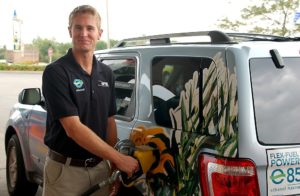 “I am very happy to be joining a quality organization such as Rahal Letterman Racing,” Hunter-Reay said. “This is a strong opportunity for me and I am eager to help the team move forward and get some results through the remainder of the season.”
“I am very happy to be joining a quality organization such as Rahal Letterman Racing,” Hunter-Reay said. “This is a strong opportunity for me and I am eager to help the team move forward and get some results through the remainder of the season.”
The handsome young driver from Texas jumped right into it and made his series debut at the Honda 200 at Mid-Ohio Sports Car Course, starting 10th and finishing 7th. Despite only competing in six races, Hunter-Reay was able to finish 19th in points with 119 points and would win the series rookie of the year award, setting the record for fewest starts in a season by a driver who won the award.
Hunter-Reay returned to RHR and the #17 Ethanol-sponsored car in 2008 which was the best year ever for Team Ethanol. At the July 5 Camping World Indy Grand Prix at the Glen at Watkins Glen International Hunter-Reay would give Team Ethanol its first IndyCar Series race and Rahal Letterman would win their first race in four years. He finished out the season ranked 8th in points with 360 points.
However, the end of the 2008 IndyCar Season was the end of the road for Team Ethanol.
Slunecka Leaves EPIC and Goes CellulosicNot long after the final race of the 2007 IndyCar season EPIC’s Tom Slunecka departed the organization as some restructuring began that would ultimately lead to a complete change in direction. For Slunecka, that meant moving on to a new opportunity and a new challenge with a company looking to move into the cellulosic ethanol business using ponderosa pine wood chips as feedstock.
After three years, EPIC had grown to become a successful promotional force for the ethanol industry at a critical time. “We have over 60 ethanol plants producing about 3.4 billion gallons of ethanol that are supporting this organization, their support comes in through a mechanism that looks much like a check off, although a voluntary check off,” said Slunecka during an interview in October 2007. “We were able to cross thresholds that most people didn’t think we ever could.”
By the end of 2008, EPIC ceased to exist and was absorbed into a new ethanol advocacy group called Growth Energy.


